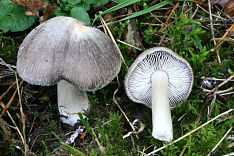Tricholoma terreum
| Tricholoma terreum | |
|---|---|
 | |
| Scientific classification | |
| Kingdom: | Fungi |
| Division: | Basidiomycota |
| Class: | Agaricomycetes |
| Order: | Agaricales |
| Family: | Tricholomataceae |
| Genus: | Tricholoma |
| Species: | T. terreum |
| Binomial name | |
| Tricholoma terreum (Schaeff.) P.Kumm. | |
| Synonyms | |
|
Tricholoma myomyces (Pers.) J.E.Lange | |
| Tricholoma terreum | |
|---|---|
|
| |
| gills on hymenium | |
|
cap is convex or flat | |
| hymenium is adnexed | |
| stipe is bare | |
|
spore print is white to cream | |
| ecology is mycorrhizal | |
| edibility: edible | |
Tricholoma terreum, commonly known as the grey knight or dirty tricholoma, is a grey-capped edible mushroom of the large genus Tricholoma. It is found in coniferous woodlands in Europe, and has also been encountered under introduced pine trees in Australia.
Taxonomy
It was originally described as Agaricus terreus by Jacob Christian Schäffer in 1762, and as Agaricus myomyces by mycologist Christian Hendrik Persoon in 1794. It was given its current binomial name by German Paul Kummer in 1871. It is commonly known as the grey knight[1] from its discoloured gills.[2] According to some European mycologists, Tricholoma myomyces is a synonym, but this is not universally accepted.[3]
Description
The cap is 4–7 cm (1.6–2.6 in) wide and evenly covered in fine grey scales. Convex with a slight boss, it is broadly conical in shape. The whitish stipe is 3–8 cm (1.2–3.2 in) high and 1.5 cm wide and has no ring. There is no ring or volva. The whitish flesh is thin, easily broken, and has a pleasant mild (not mealy) smell and taste. The widely spaced and uneven gills are free (unattached to the stipe). The spore print is white, the oval spores 6–7 μm long by 3.5-4.4 μm wide.[1][2]
It could be confused with the larger (and poisonous) T. pardinum has a mealy smell and cap scales; the edible T. orirubens has fine dark scales and pinkish gills.[4]
Distribution and habitat
Tricholoma terreum is found in Europe, where fruiting bodies appear under conifers, particularly pine and spruce, from late summer to late autumn.[1] They may also arise in parks near these trees, and grow in fairy rings.[2] They are generally in quite densely populated groups though not bunched. It has been recorded growing under exotic Pinus radiata plantations in Australia.[5][6]
Edibility
With a mild taste, the species is regarded as a good edible. It is seen in markets in France, along with Clitocybe nebularis and Tricholoma portentosum.[2] However, some authorities recommend that inexperienced pickers avoid all grey tricholomas.[7] They need to be eaten within a day or two of picking since the gills and flesh yellow and spoil quickly.
See also
References
- ↑ 1.0 1.1 1.2 Phillips, Roger (2006). Mushrooms. Pan MacMillan. p. 107. ISBN 0-330-44237-6.
- ↑ 2.0 2.1 2.2 2.3 Lamaison, Jean-Louis; Polese, Jean-Marie (2005). The Great Encyclopedia of Mushrooms. Könemann. p. 89. ISBN 3-8331-1239-5.
- ↑ Bessette AE, Bessette AR, Trudell SA, Roody WC. (2013). Tricholomas of North America: A Mushroom Field Guide. Austin, Texas: University of Texas Press. p. 108.
- ↑ Haas, Hans (1969). The Young Specialist looks at Fungi. Burke. p. 144. ISBN 0-222-79409-7.
- ↑ Grey, Ed and Pat (2006). "FNCV FUNGI GROUP FORAY: LERDEGERG RIVER WALK, JACK CANN RESERVE, BLACKWOOD, 2 July 2006". Royal Botanic Gardens Melbourne website- fungimap section. Royal Botanic Gardens Melbourne. Retrieved 2009-02-21.
- ↑ Keane, Philip J.; Kile GA, Podger FD (2000). Diseases and Pathogens of Eucalypts. Canberra: CSIRO Publishing. p. 84. ISBN 0-643-06523-7.
- ↑ Zeitlmayr, Linus (1976). Wild Mushrooms: An Illustrated Handbook. Garden City Press, Hertfordshire. pp. 72–73. ISBN 0-584-10324-7.